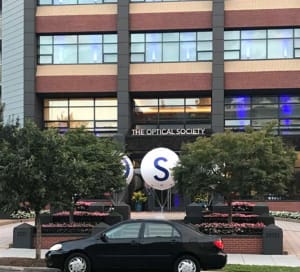FiO 2017 Tomohiro Tetsumoto
Research
OSA FRONTIERS IN OPTICS (FIO) Participation Report
Ph.D.3Tomohiro Tetsumoto, senior
Outline
I attended the international conference Frontiers in Optics (FiO) held in Washington, D.C., U.S.A., from September 17 to 21. FiO is a conference organized by the Optical Society of America (OSA) and is held annually in various locations in the United States. This year, the conference was held in Washington, the home of the Optical Society of America (OSA), and I was able to see the building where OSA is headquartered. The conference as a whole seemed to focus on poster presentations this year, and there were innovative attempts such as rapid fire oral presentations and electronic posters to introduce several excellent poster submissions in advance.

2. regarding his/her presentation
I gave a poster presentation on how to maximize the coupling efficiency of silica nanobeam resonators to about 10 people. I received many questions about the fundamentals of my research, and I received several questions about the fabrication method of dimpled nanofibers, probably due to the fact that my presentation was given in a place where fiber-related research was gathered. One of them had experience in dimpled fiber fabrication and shared his difficulties with me, but he told me that he had recently been working on a different method and told me about a paper on this fabrication method accepted by Optica. Overall, I had no particular difficulty in answering the questions, but I am aware that my answers were a little on the small side in terms of being pinpointed, so I may need to prepare more in advance to organize my thoughts.
3. Topic Introduction
FM3A.1. Progress on Multilayer Silicon Nitride-on-Silicon Integrated Photonic Platforms Joyce K. Poon
Invited lecture from University of Toronto. D. student presented the paper. D. student from the University of Toronto gave a presentation on the group's optical devices such as grating couplers, mode converters, and modulators on a silicon node platform. They have been fabricating difficult multilayer structures in cooperation with A*STAR, and have also been fabricating structures that require many experimental trials, such as modulators with U-shaped carrier distribution. Silicon nide platforms are often used in advanced research such as carcom generation, but I have often heard that there are problems such as substrate cracking due to the difference in Young's modulus from other materials, so I thought there might be various issues for industrial implementation. However, this research was conducted using CMOS-compatible equipment and processes (although it is unclear whether the wafers were made using 6-inch, 8-inch, or other large wafers), and I have changed my mind, believing that there is already a technology that can solve the problems I had feared.
- Categories
- 国際会議報告


